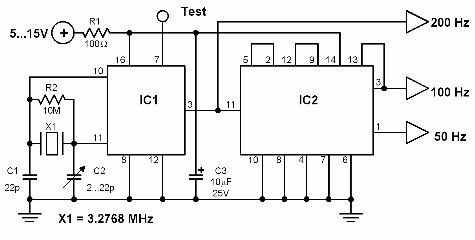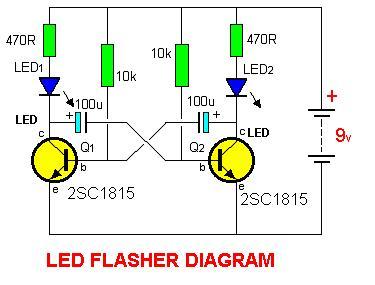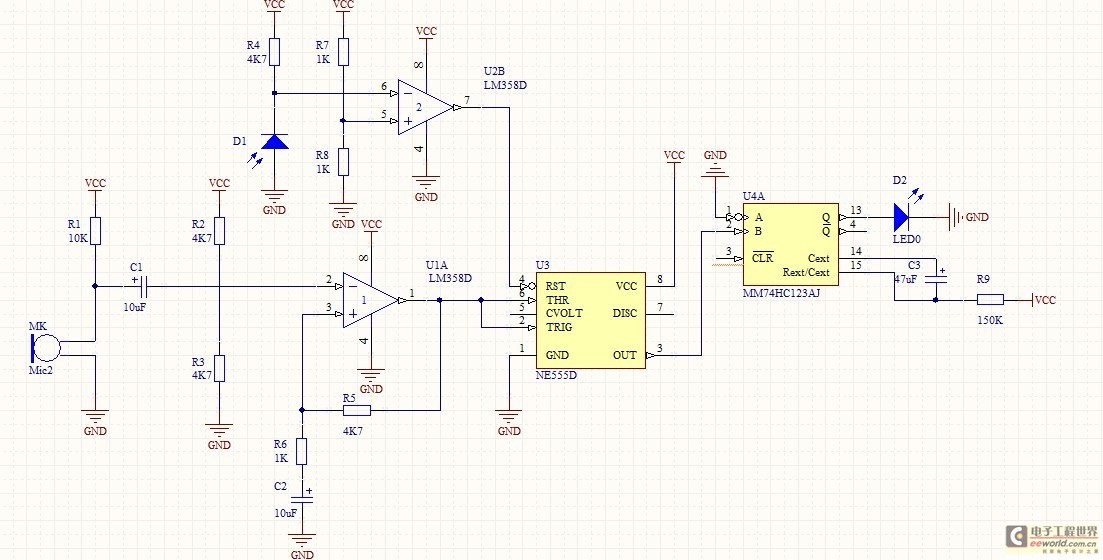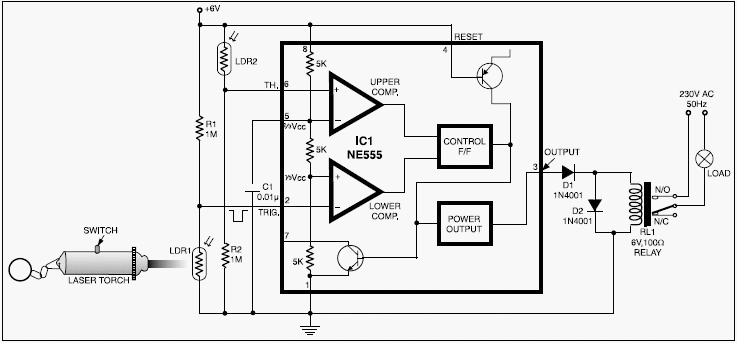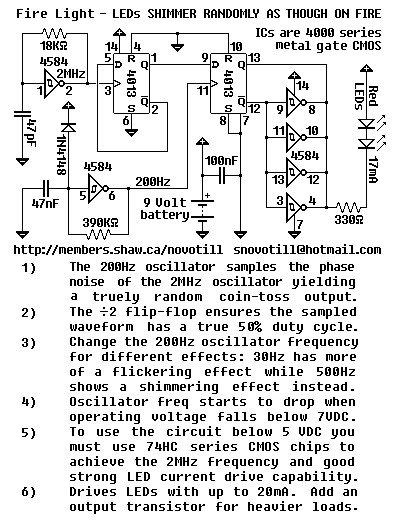
30mA LED Dimmer
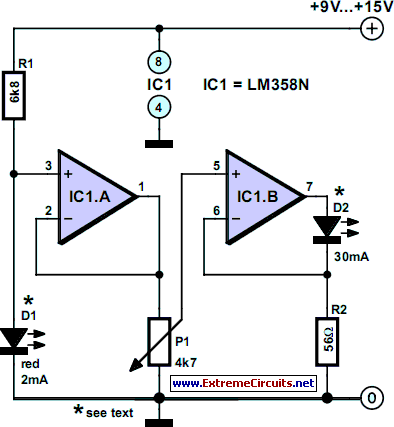
If you have ever attempted to dim an LED using a simple potentiometer, it is recognized that this method is not very effective. Similar to standard diodes, the voltage-current characteristic of LEDs is non-linear. Consequently, depending on the potentiometer setting, the brightness of the LED changes very little until a sudden variation occurs at the end of the adjustment. The optimal solution to this issue is to power the LED from a current source that allows for a full 0 to 100% adjustment range. The circuit presented here demonstrates this approach. A low-current LED (D1) is utilized to generate a reference voltage, which is first buffered by one half of an LM358 operational amplifier. The current source responsible for powering the LED is constructed around the second op-amp in the chip. The potentiometer facilitates the adjustment of the output current, with resistor R2 functioning as a current sensing element, dropping the same voltage as that produced by the potentiometer. According to Ohm's law, the maximum current through R2 reaches approximately 29 mA (I_LED = 1.6 V / 56 Ω). If needed, the current can be modified to accommodate different LED types; for instance, 20 mA can be achieved with R2 = 82 Ω and 10 mA with R2 = 150 Ω. It is also feasible to connect multiple LEDs in series. The total voltage available for the LEDs is determined by the voltage drop across the series resistor and the op-amp, as well as the supply voltage. Thus, the maximum number of LEDs can be calculated from U_LED,total = U_batt - 1.6 V. In principle, the supply voltage can be increased to 30 V to connect even more LEDs in series; however, this requires an increase in the value of the series resistor R1 to avoid overloading the low-current LED used for the voltage reference. When experimenting with larger arrays of LEDs, the maximum loading capacity of the op-amps must be considered. The DIP version of the LM358 can dissipate up to 830 mW. Power consumption, P, is calculated using the formula P = U_batt - 1.6 V * I_LED,max.
The circuit design utilizes an LM358 operational amplifier to create a reliable current source for driving LEDs effectively. The first half of the LM358 serves to buffer the reference voltage generated by the low-current LED (D1), which stabilizes the voltage level for the current source. The second half of the LM358 is configured as a current source, allowing for precise control of the output current supplied to the LED.
The potentiometer is connected in such a way that it varies the voltage at the non-inverting input of the op-amp, thereby controlling the output current. The resistor R2 is strategically placed to sense the current flowing through the LED, ensuring that the current remains within the desired range. The relationship between the resistance of R2 and the current through the LED can be adjusted to accommodate various LED specifications, making this circuit versatile for different applications.
When multiple LEDs are connected in series, the voltage drop across each LED must be considered in conjunction with the total supply voltage. The calculated maximum number of LEDs that can be connected in series is contingent upon the available supply voltage and the voltage drop across the series resistor R1. Increasing the supply voltage to 30 V allows for a greater number of LEDs; however, care must be taken to ensure that R1 is adjusted accordingly to prevent excessive current from damaging the reference LED.
The thermal performance of the LM358 must also be monitored, especially when driving larger LED arrays. The maximum power dissipation of 830 mW for the DIP version indicates that the circuit must be designed to operate within safe limits to prevent overheating. Calculating the power consumption using the given formula ensures that the design remains efficient and reliable, facilitating safe operation across various configurations. This current source circuit is ideal for applications requiring dimmable LED lighting, providing smooth and linear brightness control.If you`ve ever tried dimming a LED with a simple potentiometer, you know that the approach does not work very well. Just as with ordinary diodes, the voltage-current characteristic of LEDs is far from linear. The result depending on the potentiometer setting the LED brightness will hardly change most of the time as the pot is turned and a sudden variation at the end.
The best method to tackle this problem is to power the LED from a current source with zero to 100% adjustment range. The circuit shown here is an example. A low-current LED (D1) is used to generate a reference voltage that`s first buffered by one half of an LM358.
The actual current source that powers the LED is built around the second opamp in the chip. The potentiometer allows the output current to be adjusted, with R2 acting as a current sense, the resistor dropping the same voltage as the one obtained from the pot. Using Ohm`s law we find that the maximum current through R2 amounts to about 29 mA (I LED = 1. 6 V / 56 ©). If necessary, the current may be adapted to suit other LED types, for example, 20 mA is obtained with R2 = 82 © and 10 mA at R2 = 150 ©.
It is also possible to connect several LEDs in series. The total voltage available for the LEDs is determined by the voltage drop across series resistor and the opamp, and, of course, the supply voltage. In this way, the highest number of LEDs may be found from ULED, total = Ubatt 5. 1 V. In principle, it is possible to increase the supply voltage to 30 V in order to connect even more LEDs in series.
This does, however, call for the value of series resistor R1 to be increased to prevent overloading the low-current LED used in the voltage reference. If you intend to experiment with larger numbers of LEDs (say, in arrays) then the maximum loading of the opamps becomes an issue.
The DIP version of the LM358 may dissipate up to 830 mW. The power, P, is calculated from P = Ubatt 1. 6 ULED, total G— I LED, max. 🔗 External reference
The circuit design utilizes an LM358 operational amplifier to create a reliable current source for driving LEDs effectively. The first half of the LM358 serves to buffer the reference voltage generated by the low-current LED (D1), which stabilizes the voltage level for the current source. The second half of the LM358 is configured as a current source, allowing for precise control of the output current supplied to the LED.
The potentiometer is connected in such a way that it varies the voltage at the non-inverting input of the op-amp, thereby controlling the output current. The resistor R2 is strategically placed to sense the current flowing through the LED, ensuring that the current remains within the desired range. The relationship between the resistance of R2 and the current through the LED can be adjusted to accommodate various LED specifications, making this circuit versatile for different applications.
When multiple LEDs are connected in series, the voltage drop across each LED must be considered in conjunction with the total supply voltage. The calculated maximum number of LEDs that can be connected in series is contingent upon the available supply voltage and the voltage drop across the series resistor R1. Increasing the supply voltage to 30 V allows for a greater number of LEDs; however, care must be taken to ensure that R1 is adjusted accordingly to prevent excessive current from damaging the reference LED.
The thermal performance of the LM358 must also be monitored, especially when driving larger LED arrays. The maximum power dissipation of 830 mW for the DIP version indicates that the circuit must be designed to operate within safe limits to prevent overheating. Calculating the power consumption using the given formula ensures that the design remains efficient and reliable, facilitating safe operation across various configurations. This current source circuit is ideal for applications requiring dimmable LED lighting, providing smooth and linear brightness control.If you`ve ever tried dimming a LED with a simple potentiometer, you know that the approach does not work very well. Just as with ordinary diodes, the voltage-current characteristic of LEDs is far from linear. The result depending on the potentiometer setting the LED brightness will hardly change most of the time as the pot is turned and a sudden variation at the end.
The best method to tackle this problem is to power the LED from a current source with zero to 100% adjustment range. The circuit shown here is an example. A low-current LED (D1) is used to generate a reference voltage that`s first buffered by one half of an LM358.
The actual current source that powers the LED is built around the second opamp in the chip. The potentiometer allows the output current to be adjusted, with R2 acting as a current sense, the resistor dropping the same voltage as the one obtained from the pot. Using Ohm`s law we find that the maximum current through R2 amounts to about 29 mA (I LED = 1. 6 V / 56 ©). If necessary, the current may be adapted to suit other LED types, for example, 20 mA is obtained with R2 = 82 © and 10 mA at R2 = 150 ©.
It is also possible to connect several LEDs in series. The total voltage available for the LEDs is determined by the voltage drop across series resistor and the opamp, and, of course, the supply voltage. In this way, the highest number of LEDs may be found from ULED, total = Ubatt 5. 1 V. In principle, it is possible to increase the supply voltage to 30 V in order to connect even more LEDs in series.
This does, however, call for the value of series resistor R1 to be increased to prevent overloading the low-current LED used in the voltage reference. If you intend to experiment with larger numbers of LEDs (say, in arrays) then the maximum loading of the opamps becomes an issue.
The DIP version of the LM358 may dissipate up to 830 mW. The power, P, is calculated from P = Ubatt 1. 6 ULED, total G— I LED, max. 🔗 External reference
Warning: include(partials/cookie-banner.php): Failed to open stream: Permission denied in /var/www/html/nextgr/view-circuit.php on line 713
Warning: include(): Failed opening 'partials/cookie-banner.php' for inclusion (include_path='.:/usr/share/php') in /var/www/html/nextgr/view-circuit.php on line 713
